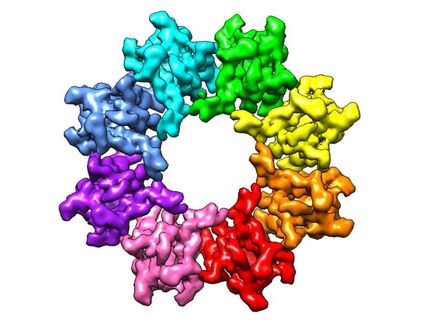How estrogen regulates gene expression
estrogen hormones regulate gene expression. They achieve this by first binding to estrogen receptor in the cell nucleus, which triggers the recruitment of different molecules called coactivators in specific order. In a study a team of researchers at Baylor College of Medicine, the University of Texas MD Anderson Cancer Center and the University of Texas Health Science Center at Houston shows that the sequential recruitment of coactivators is not simply adding molecules to the complex, it results in dynamic specific structural and functional changes that are necessary for effective regulation of gene expression.
Estrogens are a group of hormones that are essential for normal female sexual development and for the healthy functioning of the reproductive system. They also are involved in certain conditions, such as breast cancer. Estrogen also plays a role in male sexual function. Estrogens carry out their functions by turning genes on and off via a multi-step process. After estrogen binds to its receptor, different coactivators bind to the complex in a sequential manner.
"Experimental evidence suggests that different estrogen-receptor coactivators communicate and cooperate with each other to regulate gene expression," said corresponding author Dr. Bert O'Malley, chair and professor of molecular and cellular biology and Thomas C. Thompson Chair in Cell Biology at Baylor College of Medicine. "However, how this communication takes place and how it guides the sequence of events that regulate gene expression was not clear."
In this study, O'Malley, Dr. Wah Chiu, Distinguished Service Professor and Alvin Romansky Professor of Biochemistry and Molecular Biology at Baylor during the development of this project, and their colleagues combined cryo-electron microscopy structure analysis and biochemical techniques and showed how the recruitment of a specific coactivator - CARM1 - into the complex guides the subsequent steps leading to gene activation.
"For the estrogen receptor complex to be able to regulate gene expression, the coactivator CARM1 needs to be added after other coactivators have been incorporated into the complex," said first author Dr. Ping Yi, assistant professor of molecular and cellular biology at Baylor. "We discovered that when CARM1 is added, it changes the complex both chemically and structurally, and these changes guide subsequent steps that lead to gene activation." [See video of molecular interactions]
"We now have a better understanding of how this molecular machine works and of what role each one of the components plays. We are better prepared to understand what might have gone wrong when the machine fails," O'Malley said.
Original publication
Ping Yi and Zhao Wang and Qin Feng and Chao-Kai Chou and Grigore D. Pintilie and Hong Shen and Charles E. Foulds and Guizhen Fan and Irina Serysheva and Steven J. Ludtke and Michael F. Schmid and Mien-Chie Hung and Wah Chiu and Bert W. O’Malley; "Structural and Functional Impacts of ER Coactivator Sequential Recruitment"; Molecular Cell; 2017
Most read news
Original publication
Ping Yi and Zhao Wang and Qin Feng and Chao-Kai Chou and Grigore D. Pintilie and Hong Shen and Charles E. Foulds and Guizhen Fan and Irina Serysheva and Steven J. Ludtke and Michael F. Schmid and Mien-Chie Hung and Wah Chiu and Bert W. O’Malley; "Structural and Functional Impacts of ER Coactivator Sequential Recruitment"; Molecular Cell; 2017
Topics
Organizations
Other news from the department science

Get the analytics and lab tech industry in your inbox
By submitting this form you agree that LUMITOS AG will send you the newsletter(s) selected above by email. Your data will not be passed on to third parties. Your data will be stored and processed in accordance with our data protection regulations. LUMITOS may contact you by email for the purpose of advertising or market and opinion surveys. You can revoke your consent at any time without giving reasons to LUMITOS AG, Ernst-Augustin-Str. 2, 12489 Berlin, Germany or by e-mail at revoke@lumitos.com with effect for the future. In addition, each email contains a link to unsubscribe from the corresponding newsletter.






















































